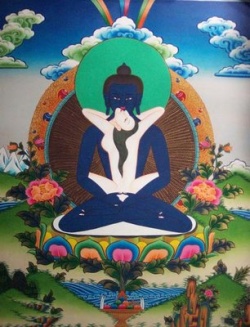Mi-tsung
Mi-tsung literally means "School of Secrets" is the Tantric school of Chinese Buddhism. The Tantric school is an extension of Mahayana and it believes that Buddhahood can be attained in the current life with intensive tantric training. The principle of Mi-tsung is similar to the Tibetan tantric schools with an exception that Mi-tsung believes the enlightenment can be achieved without sexoyogic practice.
This tradition was brought to China in the 8th century by three Indian masters of Tantra. They are :
Subhakarasimha (Chinese, Shan-wu-wei, 637-735): who came to the capital city of Tang Dynasty "Chan-Yan" in 716 A.D. and began to translate the Mahavairochana-sutra, the basic scripture of the school, into Chinese. This sutra contains the essential Tantric teachings. Because of his mystical power and profound teaching in this school, he was bestowed the title "teacher of the nation" by the emperor.
Vajrabodhi(Chinese, Chin-kang-chih, 663-723): who came to China in 720 A.D. and translated some important Tantric sutras with Amoghavajra and a Chinese monk I-Shin (673-727).
Amoghavajra (Chinese, Pu-kung, 705-774): who transmitted the magical formulas (mantra, dharani) appertaining to his tantric followers. Who was the personal teacher of three emperors of Tan Dynasty.
The esoteric teachings of the Mi-tsung were transmitted only orally from master to disciple. "Secret" indicates that these practices should be done in private. This is why the school could not become widespread in China. The dependency of complex ritual instruments and sophisticated liturgies had limited the teaching to a small group of rich followers. It is not surprised that after the death of Amoghavajra this school quickly decreased in importance and eventually disappeared in China.
This tradition was brought to Japan in Tang Dynasty and is still an active school in Japan.
